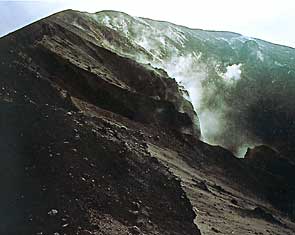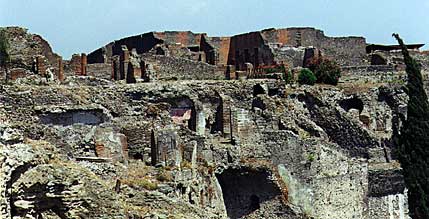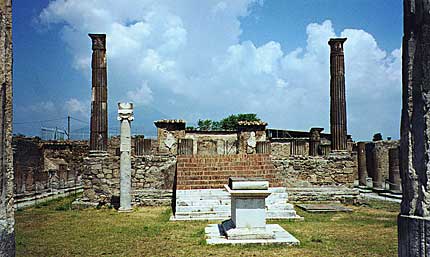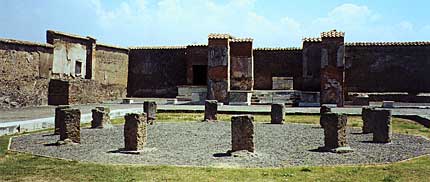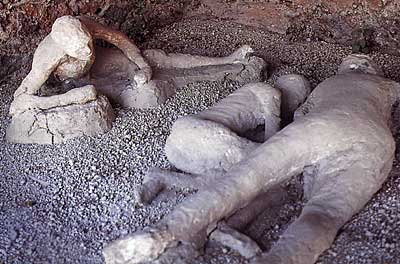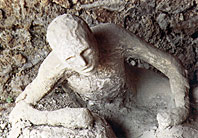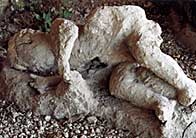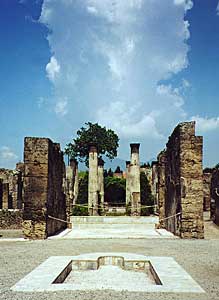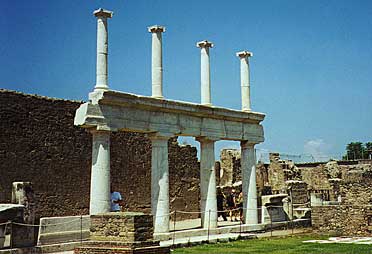|
September 16, 2002 Mr. Sedivy's Site Has Moved Please Use the NEW Site!
|

|


|
|
|
Mr. Sedivy's
|
Highlands Ranch High School - Mr. Sedivy
In the early afternoon hours of August 24, 79 A.D. the summit of Mount Vesuvius exploded without warning. A black river of ash and lapilli ran from the crater of the volcano down through the city of Pompeii leaving death and destruction in its wake. The magnificent ancient city of Pompeii was left buried under about 20 feet of earth and ash. Pompeii was originally only 500 meters from the sea, but after the eruption the distance to the sea increased to two kilometers.
Oscans settled along the shore of the Tyrrhenian Sea on an elevated lavic spur that was created by an ancient erution of Vesuvius during the 8th century B.C. The strategic location made Pompeii an object of great importance to the Estuscans. The Samnites arrived from the mountains of Irpinia in the 5th century, putting an end to the control of Campania by the Greeks and Etruscans. It was inevitable that Pompeii would fall under the domination of Rome at the beginning of the Samnite Wars. Pompeii became a Roman colony in 80 B.C., taking the name "Colonia Veneria Cornelia Pompeii" which refers to both her conquerer and to the goddess Venus.
Seventeen-hundred years later, architect Domenico Fontana happened across some inscriptions while building a tunnel in the area. Some excavation was done near the amphitheater at that time, but no one suspected that an entire city was buried there. The first scientific exploration of the site took place in 1748, directed by Charles of Bourbon. In 1860 Giuseppe Fiorelli invented a system of pouring liquid plaster into the spaces left in the ash bed.
Victims had remained in the House of the Fugitives during the volcanic eruption and the fall of lapilli. Later they had tried to escape under the ashes, but suffocated.
The oldest buildings of Pompeii date to the 6th century B.C. and likely only occupied a small part of the south-western area, between the main Forum and the Triangular Forum. Pompeii gradually expanded toward the east and the north. Most of the ruins date back to its establishment as a Roman colony in 80 B.C. Entrance to the Ruins and Roads of Pompeii - III Temples of Apollo, Isis, and Jupiter - V Water Supply and the Baths of Pompeii - VI Pompeii's Mills, Bakery, Laundry, and Brothel - VII Court of the Gladiators,
Amphitheatre, and
|
Highlands Ranch High School ![]() 9375 South Cresthill Lane
9375 South Cresthill Lane ![]() Highlands Ranch, Colorado 80126
Highlands Ranch, Colorado 80126 ![]() 303-471-7000
303-471-7000
Mr. Sedivy's History Classes
| Colorado History | American
Government | Modern European History | Advanced
Placement European History | Rise of England
| World History |
| Home | Back to the top of page
| Site Contents |

